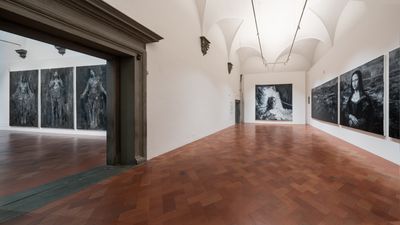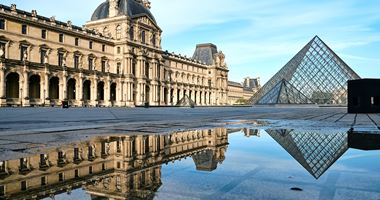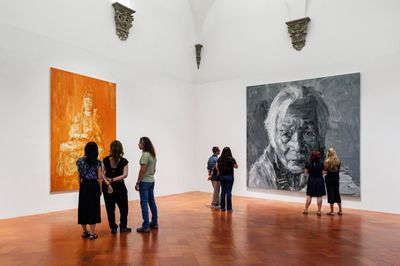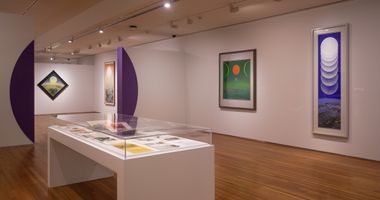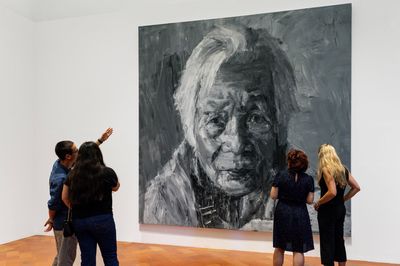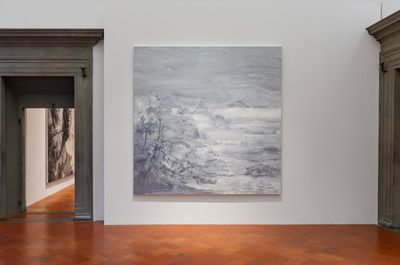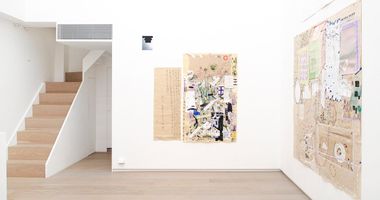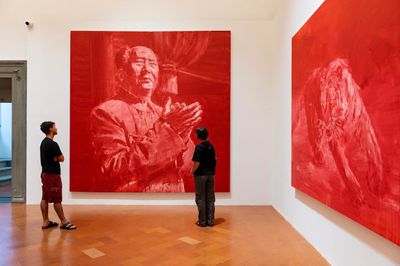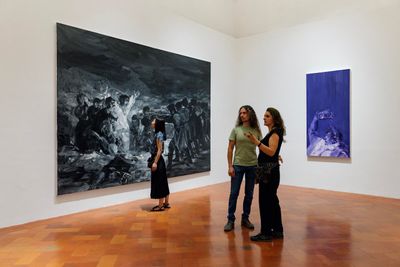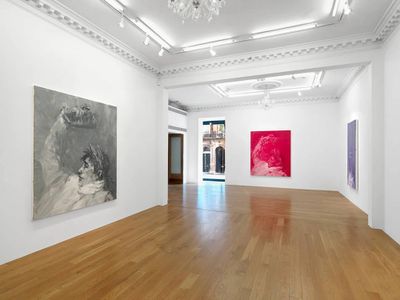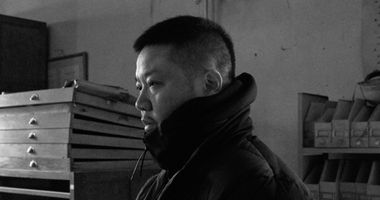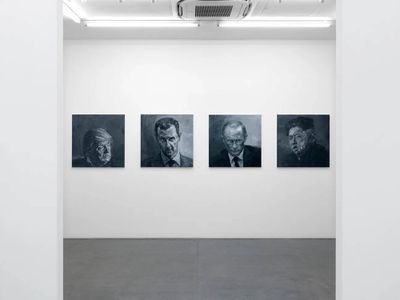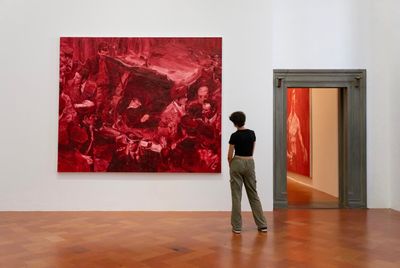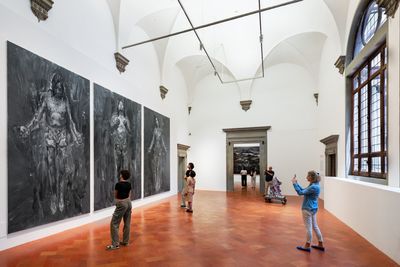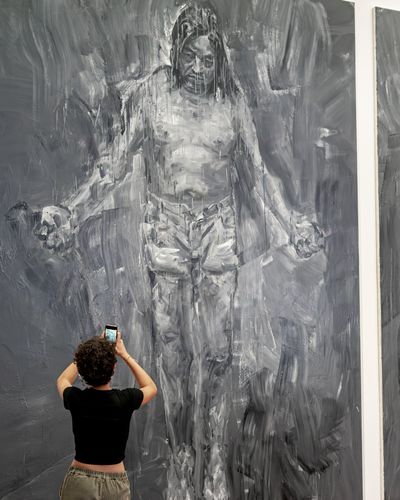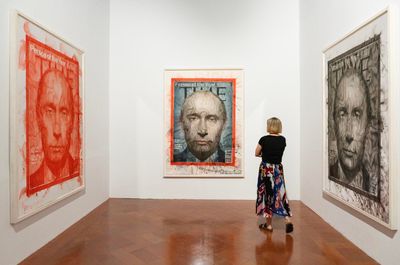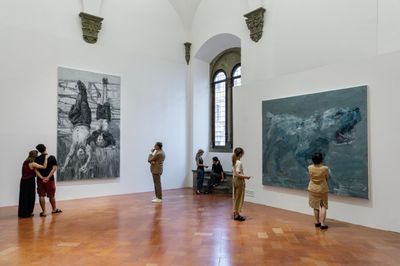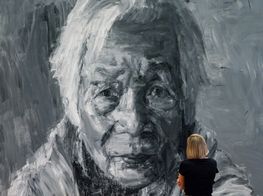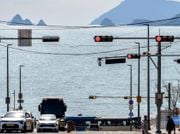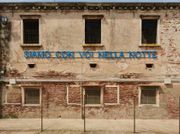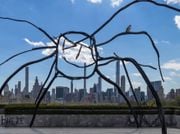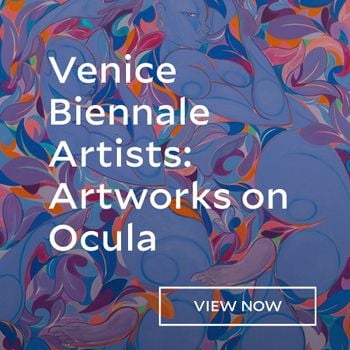Yan Pei-Ming: A Witness to History
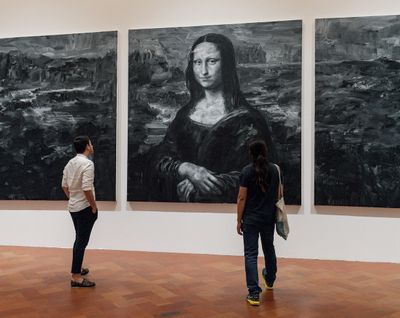
Yan Pei-Ming, Les Funérailles de Monna Lisa (The Funeral of Mona Lisa) (2009) (detail). Polyptych oil on canvas. 280 x 280 cm. Exhibition view: Painting Histories, Palazzo Strozzi, Florence (7 July–3 September 2023). Photo: Ela Bialkowska, OKNO studio.
In Florence, there are posters of the Mona Lisa everywhere. But the refined colour blends defining da Vinci's portrait of the world's most famous Florentine have been replaced with Yan Pei-Ming's meandering white impasto contours, smooth grey finishes, and fine black drips.
These posters lead to Painting Histories (7 July–3 September 2023), a solo show of Yan's paintings at Palazzo Strozzi, commissioned in the late-15th century by merchant, banker, and Medici rival, Filippo Strozzi. There, the pentaptych Les Funérailles de Monna Lisa (The Funeral of Mona Lisa) (2009) is arranged on three walls of one gallery like a winged altarpiece.
At the centre of the main wall is a rendering of Mona Lisa in greyscale oil paint on a 2.8 by 2.8 metre canvas. On either side, a 5-metre wide painting extends the landscape behind da Vinci's subject with tempestuous strokes that barely register any detail beyond shadow and light. On the side walls are two greyscale portraits: Yan's dying father looking out from his bed on the left and the artist as a young man on his own deathbed on the right.
Every image wrestles with the fact that all of the people that Yan portrays, no matter how powerful, are as pathetically human as the rest of us.
The first Les Funérailles was commissioned by the Louvre in 2008, when Yan was invited to create an exhibition that responded to its context. That version is lighter and smoother: near-monochromatic dove-grey strokes create the impression of a facsimile, with skulls worked into the landscape based on scans of the artist's own.
Yan has described the composition as an homage and funeral for Mona Lisa, whom he calls 'a mystery, like death itself'. In Florence, that mystery is infused with a turbulent melancholy, with this iteration defined by its contrasts, whether through tonal extremes or strokes that range from abstract expressionist to hyper real.
In Painting Histories, Les Funérailles acts like a coda for the portraits that define Yan's life's work: large monochromatic compositions where realist faces emerge from non-figurative strokes across a single-toned plane. This comes across in the preceding room, where Ma mère (2018), a gut-punch 3.5 by 3.5-metre portrait of Yan's late mother, holds court.
An old woman looks directly at viewers, as absorbing grey shadows carve out a powerfully furrowed brow and white highlights define the lightness of a flipped-back fringe. A downpour of scratch-like drips fall over her like rain, towards a mound of fabric wrapped around the neck and shoulders, where wider and less-defined brushwork recalls the voluminous landscapes of Les Funérailles.
Suddenly, the monumentality of Ma mère makes sense, beyond the visceral and tactile experience of viewing the dizzying mesh of strokes that compose the piece. A portrait of a mother is treated with the magnitude of a mountain, just as Yan offers the landscape in Mona Lisa the same attention as its subject. In keeping, Ma mère is positioned to face Paradis Céleste pour ma mère (2023), where shadow-like branches stretch over a view of pale grey, cloud-shrouded highlands.
This intersection of land and figure is triangulated with a third canvas in the room. Bouddha pour ma mère (2023) shows Guanyin, a popular figure in East Asian Buddhism and Taoism, rendered in orange with luminous emerald green undertones.
While Bouddha pour ma mère points to the artist's childhood in Shanghai, where he and his family lived for a time in disused Buddhist temples—not to mention the forbidden Buddhist images that he painted for his mother during the Cultural Revolution—it also speaks to Yan's approach to figurative abstraction.
Known in Mahayana Buddhism as Boddhisattva Avalokiteshvara, the embodiment of compassion, Guanyin, whose spiritual home is Mount Potalaka in South India, is sometimes referred to as the 'Buddhist Madonna'.1
Congregating in this figure, then, are the elements embodied by each painting in this grouping: of land, an archetype, and its embodiment. Each is a universal form grounded in reality, which encapsulates the exercise in contemplating the real and iconic that charges Yan's practice.
Among the portraits in Painting Histories is Mao rouge (2006), a large, red iteration of Chairman Mao, whom Yan has painted since his youth in China. Standing on a balcony looking down, Mao's eyes embody the Mona Lisa effect. They follow viewers around the room like a surveillance camera, echoing the glowing eyes of the red tiger on the hunt in the painting next to him.
In another gallery, a watercolour triptych from 2023 recreates the TIME magazine cover dedicated to Ukrainian president Volodymyr Zelensky in December 2022, presented alongside a long, landscape-format watercolour scroll filled with red skulls painted in response to the Russian invasion of Ukraine. Next door, another trio of watercolours show another TIME cover declaring Vladimir Putin 'Person of the Year' in 2007.
Connecting these two rooms is another where paintings recreate works by historical masters. There's a black-and-white rendition of Goya's The Third of May 1808, completed in 1814 to commemorate the execution of Spanish resistance fighters by Napoleon's army, this time with dead bodies replaced with pools of white paint.
Nearby, a purple oil on canvas from 2017 based on Jacques-Louis David's preparatory sketch for his 1807 painting of Napoleon's coronation, isolates the image of the so-called republican crowning himself to become the very thing the French Revolution—of which Napoleon played a leading part—sought to abolish.
Yan first presented this Napoleonic series in 2017 in a solo show at MASSIMODECARLO in London titled A Short History of Power and Death. There, greyscale portraits of Donald Trump, Putin, Bashar al-Assad, and Kim Jong-Un faced a large-scale canvas painted after Manet's 1868 painting of Emperor Maximilian's execution in Mexico, which borrows heavily from Goya's The Third of May 1808.
In Yan's treatment, the face-off between four world leaders and this historical event is at once a threat, warning, and suggestion of what might befall these men. Such sharp confrontations extend to the contradictions that define so many of the figures and events that Yan commemorates.
All four portraits appear in the artist's exhibition in Austria at Francisco Carolinum Linz, aptly titled Portraits (24 May–13 August 2023), as part of 'Game of Power'. Started in 2017, Yan says this series will continue for the rest of his life.
'Portrait is like a mirror,' the artist has said, 'it reflects to us who we are, what we are.'
Amid the faces of contemporary figures like Mohammed bin Salman and Xi Jinping and historic figures like Churchill and Sheikh Zayed bin Sultan al Nahyan, the founding father of the U.A.E., are portraits anchoring this Linz installation to its context, of Austrian Archduke Franz Ferdinand and his assassin Gavrilo Princip, both catalysts to World War I.
Hitler and his mistress Eva Braun, figures of the war that followed, also appear in the group. That notorious pairing is echoed at Palazzo Strozzi in 29 aprile 1945, Piazzale Loreto, Milano (2022), a flurried greyscale depiction of Mussolini hanging by his ankles alongside his mistress Claretta Petacci after their execution.
The work opposes Yan's study of Hubert Lanzinger's 1930s propaganda painting of Hitler as a medieval knight that was defaced by the U.S. Army—the eye was pierced—at the end of the war, which is installed next to a blue-scale depiction of a dog that seems to rage in the dictator's direction.
Yan describes 'Game of Power' as 'a history painting' as well as a 'personal story', which checks out when you consider how portraits function in the artist's practice. 'Portrait is like a mirror,' the artist has said, 'it reflects to us who we are, what we are.'2 Every image wrestles with the fact that all of the people that Yan portrays, no matter how powerful, are as pathetically human as the rest of us.
At Palazzo Strozzi, such reflections on power are expressed unflinchingly in one room anchored to postwar Italian history. Aldo Moro (9 May 1978, Rome) (2017) faithfully depicts a shocking image in redscale: the assassinated body of Italy's former prime minister, and at the time president of the Christian Democrats, crumpled in the back of a red Renault 4. While Ostia, due novembre 1975 (2023) is a blurry, greyscale copy of a photo of filmmaker Pier Paolo Pasolini's murdered body on the ground.
Both paintings confront the vulnerability of every life, no matter how untouchable some might seem, in the face of human violence. Perhaps this is why the third painting in this grouping depicts the crucifixion as shown in Pasolini's 1964 film, The Gospel According to St. Matthew, recreated in greyscale in 2023. Measuring four metres tall, Christ's face is painted so that his mouth appears like a gaping void; as if caught in a scream.
That painting circles back to the first room in Painting Histories, where Nom d'un chien ! Un jour parfait (Dammit! A Perfect Day) (2012) has been installed. Three towering, four-metre-tall canvases show the artist recreating the pose of Christ on the crucifix without the cross.
In each composition, a light-grey body emerges from a rush of broad-brush greyscale strokes, which contrast with the accumulation of sharper but no-less-expressive marks defining each figure, including the artist's face, as if emerging from an abyss.
Yan's body is bare-skinned, save for unbuttoned jean shorts that stand in for a biblical loin cloth—a hint of acerbic camp that seems to pay homage to Pasolini's radical non-conformism and open queerness, which made him something of a pariah, not only to fascists and conservatives but to the communist movement to which he was associated.
Pasolini fearlessly tore holes through the veneer of simplistic political legibility in his lifetime. Among his more controversial gestures was his 1968 poem 'The PCI to Young People', written in response to a clash between militants and police in Rome in which he saw a class war.
In the poem, Pasolini describes students as privileged 'daddy's boys' and the police as the 'sons of the poor'. While he notes that he is 'against the police as an institution', he implores readers to acknowledge the humanity of those who serve it, in order to recognise the true scale of any struggle against systemic power.
Yan seems to enact a similar appeal. By portraying world leaders and historic events with uncannily expressive realism, he turns the weight of humanity's complex impurity into a reflective mire. Good and bad collapse into a mesh of actions that are as incomprehensible as they are inextricable from the human condition. ('I ask myself', Yan states in the Painting Histories catalogue: 'How can one man shoot another?' And yet, it happens.)
As Palazzo Strozzi Director General and curator of Painting Histories, Arturo Galansino, tells me: 'This is humanity without ideology.' Yan locates that sublime in every face and body he sees, and invites audiences to bear witness alongside him.
'The art of painting is already a form of involvement,' the artist explains to Galansino in conversation. 'I make a statement, I express myself in my work, I show it to viewers, and then it's their turn to react.'3
That intention to trigger comes through in À l'est d'Eden (East of Eden) (2015), a four-by-six metre canvas depicting a dark and turbulent greyscale landscape. Only once the eyes have adjusted to the storm of brushstrokes do the images of animals tearing at one another emerge. It's like seeing in the dark. —[O]
1 Maria Reis-Habito, 'The Bodhisattva Guanyin and the Virgin Mary', Buddhist-Christian Studies, Vol. 13 (1993), pp. 61-69.
2 Yan Pei-Ming Video Interview at Francisco Carolinum Linz for Game of Power exhibition, Instagram, 15 June 2023.
3 'Yan Pei-Ming: History Painter', edited by Arturo Galansino, Marsilio Editori, 14 July 2023.

